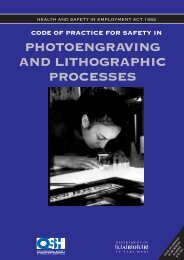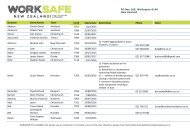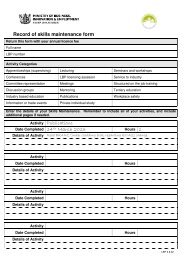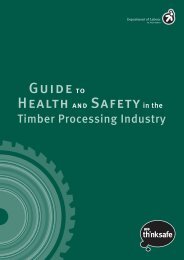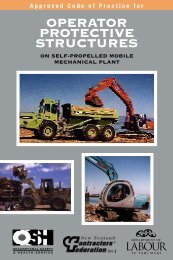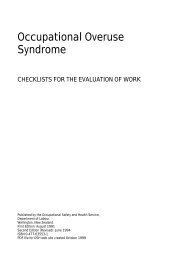Confined Space - Safe Working in a - Business.govt.nz
Confined Space - Safe Working in a - Business.govt.nz
Confined Space - Safe Working in a - Business.govt.nz
Create successful ePaper yourself
Turn your PDF publications into a flip-book with our unique Google optimized e-Paper software.
<strong>Safe</strong>ty <strong>in</strong><br />
<strong>Conf<strong>in</strong>ed</strong><br />
<strong>Space</strong>s<br />
TOGETHER<br />
Zero elim<strong>in</strong>at<strong>in</strong>g<br />
to<br />
workplace<br />
dea hs<br />
<strong>Safe</strong><br />
<strong>Work<strong>in</strong>g</strong><br />
<strong>in</strong> a<br />
<strong>Conf<strong>in</strong>ed</strong><br />
<strong>Space</strong>
<strong>Safe</strong>ty <strong>in</strong><br />
<strong>Conf<strong>in</strong>ed</strong><br />
<strong>Space</strong>s<br />
Introduction<br />
to conf<strong>in</strong>ed space safety<br />
Information Sheet No. 1<br />
<strong>Work<strong>in</strong>g</strong> <strong>in</strong> a conf<strong>in</strong>ed space is potentially one of<br />
the most dangerous of all workplace hazards. It’s<br />
been calculated that work<strong>in</strong>g <strong>in</strong> a conf<strong>in</strong>ed space is<br />
150 times more dangerous than do<strong>in</strong>g the same<br />
job outside.<br />
Over the years, many workers, <strong>in</strong> a range of<br />
occupations, have lost their lives or suffered<br />
serious harm while work<strong>in</strong>g <strong>in</strong> tanks, vats, sumps,<br />
sewers, pits, traps and other types of conf<strong>in</strong>ed<br />
space. All of these deaths and <strong>in</strong>juries could be<br />
averted by follow<strong>in</strong>g the established procedures for<br />
such work and us<strong>in</strong>g proper personal protective<br />
equipment.<br />
AUSTRALIAN STANDARD<br />
The key document is AS 2865: 1995 <strong>Safe</strong><br />
work<strong>in</strong>g <strong>in</strong> a conf<strong>in</strong>ed space. This Standard was<br />
prepared to meet the need for requirements and<br />
procedures for the prevention of occupational<br />
illness, <strong>in</strong>juries and fatalities associated with<br />
persons enter<strong>in</strong>g and work<strong>in</strong>g <strong>in</strong> a conf<strong>in</strong>ed space.<br />
It is designed not only to ensure that conf<strong>in</strong>ed<br />
spaces are made safe for those enter<strong>in</strong>g them, but<br />
also to highlight the likely hazards associated with<br />
such work areas and the relevant safe work<br />
processes necessary to deal with those hazards.<br />
The Standard emphasises the responsibilities<br />
for safety before entry and dur<strong>in</strong>g the entire<br />
operation. Such responsibilities cover conditions<br />
of work for an organisation’s own employees, as<br />
well as for any contractors or other persons on the<br />
premises. This Standard requires that adequate<br />
steps be taken to elim<strong>in</strong>ate or control hazards. It<br />
also requires that all persons <strong>in</strong>volved <strong>in</strong> the entry<br />
of a conf<strong>in</strong>ed space be tra<strong>in</strong>ed and <strong>in</strong>structed on<br />
the nature of the hazards and the precautions to<br />
be followed.<br />
This Standard conforms with the hierarchy<br />
of controls set out <strong>in</strong> the Health and <strong>Safe</strong>ty <strong>in</strong><br />
Employment Act 1992 and its use is endorsed by<br />
the Occupational <strong>Safe</strong>ty and Health Service. It is<br />
recommended that this Standard form the basis of<br />
procedures adopted <strong>in</strong> all <strong>in</strong>dustries where work is<br />
performed <strong>in</strong> conf<strong>in</strong>ed spaces.<br />
WHO NEEDS THIS INFORMATION?<br />
Industries where work has to be undertaken<br />
<strong>in</strong> a conf<strong>in</strong>ed space <strong>in</strong>clude:<br />
• Chemical <strong>in</strong>dustries<br />
• Telecommunications<br />
• Underground services<br />
• Food and beverage<br />
<strong>in</strong>dustries<br />
• Construction,<br />
• Energy <strong>in</strong>dustries,<br />
• Railways.<br />
• Shipbuild<strong>in</strong>g<br />
and repair<br />
This set of <strong>in</strong>formation sheets provides<br />
general, non-technical <strong>in</strong>formation on safe work<strong>in</strong>g<br />
<strong>in</strong> a conf<strong>in</strong>ed space, and <strong>in</strong>cludes examples of<br />
accidents. It is <strong>in</strong>tended to supplement the<br />
Standard. As well as assist<strong>in</strong>g employers, some of<br />
these sheets may be useful as employee <strong>in</strong>formation<br />
and for tra<strong>in</strong><strong>in</strong>g purposes.<br />
OTHER INFORMATION<br />
There is a large literature on the subject of<br />
work <strong>in</strong> conf<strong>in</strong>ed spaces. AS 2865 lists various key<br />
documents that were consulted <strong>in</strong> the development<br />
of the Standard, and articles on aspects of the<br />
subject are published <strong>in</strong> health and safety journals,<br />
<strong>in</strong> New Zealand and overseas. Manufacturers and<br />
suppliers of safety equipment also provide relevant<br />
<strong>in</strong>formation.<br />
Every <strong>in</strong>dustry and place of work needs to<br />
have all the technical <strong>in</strong>formation relevant to the<br />
work carried out <strong>in</strong> conf<strong>in</strong>ed spaces, and to<br />
document its procedures fully. If expertise is not<br />
available to do this with<strong>in</strong> the organisation, it is<br />
recommended that assistance be sought from a<br />
suitably qualified consultant.<br />
TOGETHER<br />
Zero elim<strong>in</strong>at<strong>in</strong>g<br />
to<br />
workplace<br />
dea hs<br />
ISSUED BY THE OCCUPATIONAL SAFETY AND HEALTH SERVICE, DEPARTMENT OF LABOUR, WELLINGTON, NEW ZEALAND
<strong>Safe</strong>ty <strong>in</strong><br />
<strong>Conf<strong>in</strong>ed</strong><br />
<strong>Space</strong>s<br />
Essential facts<br />
on conf<strong>in</strong>ed space safety<br />
Information Sheet No. 2<br />
Serious accidents have occurred and cont<strong>in</strong>ue to<br />
occur to people work<strong>in</strong>g <strong>in</strong> conf<strong>in</strong>ed spaces. A<br />
significant number of such accidents are fatal, and<br />
multiple fatalities are not uncommon. If you must<br />
work <strong>in</strong> a conf<strong>in</strong>ed space, you must observe special<br />
precautions.<br />
WHAT IS A CONFINED SPACE?<br />
A conf<strong>in</strong>ed space is any area that is not<br />
<strong>in</strong>tended for human occupancy and that also has<br />
the potential for conta<strong>in</strong><strong>in</strong>g a dangerous<br />
atmosphere. A conf<strong>in</strong>ed space:<br />
• is large enough for a worker to enter and<br />
perform assigned work;<br />
• has limited entries and exits;<br />
• may conta<strong>in</strong> a hazardous atmosphere, aris<strong>in</strong>g<br />
from chemicals, sludge or sewage;<br />
• is constructed so that anyone who enters could<br />
be asphyxiated or trapped by walls or floor that<br />
converge to a small cross-section, such as a<br />
hopper;<br />
• conta<strong>in</strong>s a material, such as sawdust or gra<strong>in</strong>,<br />
that could engulf anyone who enters.<br />
Examples of a conf<strong>in</strong>ed space <strong>in</strong>clude a tank,<br />
vessel, vat, silo, b<strong>in</strong> and vault. Others which are less<br />
obvious can be equally dangerous, e.g. open- top<br />
tanks and vats (particularly where heavier than air<br />
gases or vapours may be present), closed and<br />
unventilated rooms, or furnaces and ovens <strong>in</strong> which<br />
dangerous accumulation of gases can build up<br />
because of restricted air circulation even though<br />
the door is left open.<br />
This <strong>in</strong>formation sheet is not a substitute for<br />
special tra<strong>in</strong><strong>in</strong>g on conf<strong>in</strong>ed space entry, but gives<br />
an overview of the common hazards and suggests<br />
where specialist <strong>in</strong>formation and standards may be<br />
found.<br />
AUSTRALIAN STANDARD<br />
The recommended document for establish<strong>in</strong>g<br />
good systems and practices is the Australian<br />
Standard AS 2865 :1995 <strong>Safe</strong> work<strong>in</strong>g <strong>in</strong> a conf<strong>in</strong>ed<br />
space. The Standard was prepared for the<br />
prevention of occupational illness, <strong>in</strong>juries and<br />
fatalities associated with persons enter<strong>in</strong>g and<br />
work<strong>in</strong>g <strong>in</strong> conf<strong>in</strong>ed spaces. It is designed not only<br />
to ensure that conf<strong>in</strong>ed spaces are made safe for<br />
those enter<strong>in</strong>g them, but also to highlight the likely<br />
hazards associated with such work. Besides<br />
cover<strong>in</strong>g the conditions of work for an<br />
organisations own employees it also covers<br />
contractors or others on the premises.<br />
Additionally, by comply<strong>in</strong>g with the Standard,<br />
the pr<strong>in</strong>ciples for elim<strong>in</strong>at<strong>in</strong>g or controll<strong>in</strong>g<br />
hazards will be compatible with obligations under<br />
the Health and <strong>Safe</strong>ty <strong>in</strong> Employment (HSE) Act<br />
1992.<br />
LEGAL RESPONSIBILITIES<br />
The Health and <strong>Safe</strong>ty <strong>in</strong> Employment Act<br />
1992 places responsibilities on employers,<br />
employees, people who hire contractors, and<br />
others.<br />
If you are an employer<br />
Under the HSE Act, if you are an employer<br />
then you must take all practical steps to:<br />
• Ensure your employees are safe while at work;<br />
• Identify all hazards <strong>in</strong> a place of work; and<br />
• Where the hazards identified are significantelim<strong>in</strong>ate,<br />
isolate or m<strong>in</strong>imise your employees<br />
exposure to the hazard.<br />
You must <strong>in</strong>volve your employees <strong>in</strong> the<br />
development of procedures for identify<strong>in</strong>g and<br />
manag<strong>in</strong>g hazards <strong>in</strong> your bus<strong>in</strong>ess, <strong>in</strong>clud<strong>in</strong>g<br />
emergency plans.<br />
TOGETHER<br />
Zero elim<strong>in</strong>at<strong>in</strong>g<br />
to<br />
workplace<br />
dea hs<br />
ISSUED BY THE OCCUPATIONAL SAFETY AND HEALTH SERVICE, DEPARTMENT OF LABOUR, WELLINGTON, NEW ZEALAND
If your employees are still exposed to<br />
significant hazards, you must provide protective<br />
cloth<strong>in</strong>g and equipment for them and monitor their<br />
exposure to the hazard.<br />
In addition, you must <strong>in</strong>form your employees<br />
about the hazards <strong>in</strong> your bus<strong>in</strong>ess and the results<br />
of any monitor<strong>in</strong>g of their health or the work<br />
environment. You must take all practicable steps to<br />
tra<strong>in</strong> your employees to work safely, or have them<br />
supervised by someone with adequate qualifications<br />
and/or experience.<br />
You must also take all practical steps to<br />
ensure that while your employees are at work, they<br />
do not harm other people.<br />
If you are an employee<br />
You must not do anyth<strong>in</strong>g at work that will<br />
harm yourself or other people.<br />
If you engage a contractor<br />
You must ensure that the contractor, the<br />
contractor’s employees and any subcontractors are<br />
not harmed while do<strong>in</strong>g any work (other than<br />
residential work) that the contractor was engaged<br />
to do.<br />
RISK ASSESSMENT<br />
The Standard emphasises that the employer<br />
must ensure that a risk assessment is undertaken<br />
by a competent person before work beg<strong>in</strong>s. As far<br />
as practicable, the assessment should be <strong>in</strong> writ<strong>in</strong>g<br />
and take <strong>in</strong>to account at least the follow<strong>in</strong>g:<br />
• the work required to be done;<br />
• the range of methods by which the work can<br />
be safely done;<br />
• the hazards <strong>in</strong>volved and the associated risks;<br />
• the actual method selected and plant proposed;<br />
and<br />
• emergency and rescue procedures.<br />
The assessment should be revised whenever<br />
there is evidence to <strong>in</strong>dicate that it is no longer<br />
valid. It does not, <strong>in</strong> itself, make the job safe, but is<br />
dependent for its effectiveness on the persons<br />
concerned carry<strong>in</strong>g it out. (For a sample risk<br />
assessment, see Appendix C of the Standard.)<br />
SECURING A SAFE ATMOSPHERE<br />
Employers should ensure that a competent<br />
person assesses the atmospheric contam<strong>in</strong>ants<br />
before entry.<br />
The <strong>in</strong>itial assessment should <strong>in</strong>clude, where<br />
appropriate, an analysis of the atmosphere for<br />
contam<strong>in</strong>ants and oxygen. Forced ventilation with<br />
a blower fan is the preferred method of displac<strong>in</strong>g<br />
contam<strong>in</strong>ated air.<br />
After withdraw<strong>in</strong>g the plant from service,<br />
precautions should be taken to prevent potentially<br />
dangerous materials from enter<strong>in</strong>g it while workers<br />
are <strong>in</strong>side. The safest course is to completely<br />
disconnect the space from every other item of plant<br />
and to seal off every <strong>in</strong>let pipe. If isolation is not<br />
possible, and the space is likely to be seriously recontam<strong>in</strong>ated<br />
dur<strong>in</strong>g occupancy, cont<strong>in</strong>uous<br />
ventilation and cont<strong>in</strong>uous monitor<strong>in</strong>g is called for.<br />
All materials— solids, liquids or gases —<br />
which are liable to present a hazard <strong>in</strong>side the space<br />
must be removed. Potentially dangerous materials<br />
may be trapped <strong>in</strong> sludge, scale or beh<strong>in</strong>d loose<br />
l<strong>in</strong><strong>in</strong>gs or brickwork.<br />
Special care should therefore be exercised and<br />
clean<strong>in</strong>g processes adopted to meet each set of<br />
circumstances. Where it is necessary to enter the<br />
space to remove sludge etc. which is liable to give<br />
off dangerous fumes, suitable breath<strong>in</strong>g apparatus<br />
and, where practicable, a safety l<strong>in</strong>e should be<br />
worn, and rescue equipment and personnel should<br />
be available.<br />
With steam-volatile substances, steam<br />
clean<strong>in</strong>g will be found to be effective to remove<br />
residues. Solvents and neutralis<strong>in</strong>g agents may be<br />
employed before steam clean<strong>in</strong>g to remove nonvolatile<br />
materials. Areas conta<strong>in</strong><strong>in</strong>g flammable<br />
vapour may be purged with an <strong>in</strong>ert gas (e.g.,<br />
nitrogen, carbon dioxide) to prevent formation of<br />
explosive mixtures with air. The <strong>in</strong>ert gas should<br />
then, <strong>in</strong> turn, be purged with air and the area<br />
thoroughly tested for oxygen deficiency.<br />
Atmospheric test<strong>in</strong>g should always be<br />
considered before enter<strong>in</strong>g a conf<strong>in</strong>ed space. All<br />
spaces where flammable gases, toxic vapours and<br />
abnormal oxygen content are suspected should be<br />
tested before an entry permit is issued.<br />
Contractors, who may be unaware of any special<br />
risks, should be <strong>in</strong>cluded <strong>in</strong> the permit to work<br />
system.
Atmospheric test<strong>in</strong>g us<strong>in</strong>g an explosiometer is<br />
not normally satisfactory for assess<strong>in</strong>g possible<br />
toxic risks. In most cases, the safe explosive limits<br />
(LELs) are many times higher than the toxic limits.<br />
Test<strong>in</strong>g is a highly technical skill and it is<br />
particularly important that the competent person<br />
with this responsibility is thoroughly tra<strong>in</strong>ed.<br />
Gas detection <strong>in</strong>struments should be<br />
recalibrated at regular <strong>in</strong>tervals, e.g. weekly, or <strong>in</strong><br />
certa<strong>in</strong> circumstances, each time the <strong>in</strong>strument is<br />
used. This is to check for sensor poison<strong>in</strong>g and<br />
sensor response.<br />
RESPIRATOR CHOICE<br />
The responsible person controll<strong>in</strong>g the<br />
operation should aim to achieve a safe atmosphere<br />
where respirators are not necessary. If this is not<br />
practicable, an appropriate respirator should be<br />
considered. The decision of what constitutes an<br />
appropriate respirator depends on the likely<br />
concentration of contam<strong>in</strong>ant and/or oxygen <strong>in</strong> the<br />
conf<strong>in</strong>ed atmosphere.<br />
• Air-purify<strong>in</strong>g respirators offer no protection<br />
aga<strong>in</strong>st oxygen deficiency or oxygen<br />
enrichment. However, they can remove<br />
contam<strong>in</strong>ants from the air you breathe. To<br />
safeguard aga<strong>in</strong>st dusts, fumes and mists,<br />
respirators must be fitted with particulate<br />
filters. To protect aga<strong>in</strong>st chemical vapours<br />
and gases, respirators must be fitted with the<br />
appropriate chemical filter. Some atmospheres<br />
require respirators fitted with a comb<strong>in</strong>ation of<br />
both.<br />
• Negative-pressure air purify<strong>in</strong>g respirators<br />
should not be used when the concentration of<br />
contam<strong>in</strong>ant exceeds ten times the maximum<br />
recommended level for unprotected breath<strong>in</strong>g.<br />
Atmospheric monitor<strong>in</strong>g is requirement for<br />
this decision.<br />
• Air-supplied respirators help protect aga<strong>in</strong>st<br />
temperature extremes and heavy<br />
concentrations of dust fumes and chemical<br />
vapours.<br />
• Airl<strong>in</strong>e respirators can protect aga<strong>in</strong>st oxygen<br />
deficiency when used with a small selfconta<strong>in</strong>ed<br />
compressed air supply (sometimes<br />
called an escape bottle or a self-rescue bottle).<br />
• A self-conta<strong>in</strong>ed breath<strong>in</strong>g apparatus is useful<br />
<strong>in</strong> atmospheres that can’t be tested or where<br />
the suspected contam<strong>in</strong>ant has not been<br />
identified. This form of protection is the only<br />
acceptable type for emergency rescue<br />
personnel.<br />
PERMIT TO WORK<br />
A permit is essentially a document which sets<br />
out the work to be done and the precautions to be<br />
taken. Hav<strong>in</strong>g completed the assessment above, the<br />
permit specifies work methods. It predeterm<strong>in</strong>es a<br />
safe procedure and a clear record that all<br />
foreseeable hazards have been considered <strong>in</strong><br />
advance. An example of a typical permit is shown<br />
<strong>in</strong> Appendix G of the Standard. This permit is to be<br />
signed by a person with the authority to represent<br />
the employer.<br />
A common error is to omit contractors from<br />
the permit system. Contractor’s employees may be<br />
completely unaware of the risks <strong>in</strong> an unfamiliar<br />
workplace. The responsibility <strong>in</strong> law is with the<br />
pr<strong>in</strong>cipal management to ensure a safe workplace.<br />
No person should enter a conf<strong>in</strong>ed space without a<br />
permit from the employer.<br />
ATMOSPHERIC TESTING<br />
The standard emphasises that before a person<br />
enters a conf<strong>in</strong>ed space, test<strong>in</strong>g is carried out to<br />
ensure that:<br />
(a)<br />
(b)<br />
(c)<br />
(d)<br />
the conf<strong>in</strong>ed space conta<strong>in</strong>s a safe level of<br />
oxygen;<br />
atmospheric contam<strong>in</strong>ants <strong>in</strong> the conf<strong>in</strong>ed<br />
space are reduced to a safe level;<br />
the conf<strong>in</strong>ed space is free from extremes of<br />
temperature;<br />
the concentration of flammable contam<strong>in</strong>ant<br />
<strong>in</strong> the atmosphere is 0% of the Lower<br />
Explosive Limit (LEL) if hot work is to be<br />
carried out, or 10% if cold work is to be carried<br />
out.<br />
The employer should ensure that the<br />
atmospheric test<strong>in</strong>g is carried out consistent with<br />
the risk assessment. If it is not practicable to<br />
provide a safe oxygen level, or safe level of air<br />
contam<strong>in</strong>ant, suitable protective equipment,<br />
<strong>in</strong>clud<strong>in</strong>g air-supplied respirators are to be worn, as<br />
specified on the entry permit.
STAND-BY PERSON AND RESCUE<br />
CONSIDERATIONS<br />
A stand-by person should be stationed at the<br />
entrance to the conf<strong>in</strong>ed space to ensure that<br />
communication is constantly ma<strong>in</strong>ta<strong>in</strong>ed when the<br />
risk assessment <strong>in</strong>dicates that:<br />
(a)<br />
(b)<br />
(c)<br />
(d)<br />
(e)<br />
there may not be a safe level of oxygen;<br />
atmospheric contam<strong>in</strong>ants are present or may<br />
be present <strong>in</strong> concentrations above the safety<br />
exposure standards;<br />
there is a risk of fire or explosion;<br />
there is a risk of entrapment or engulfment;<br />
conditions outside the conf<strong>in</strong>ed space threaten<br />
the safety of people <strong>in</strong>side, e.g. respiratory air<br />
supply, vehicles and weather.<br />
RETRIEVAL EQUIPMENT<br />
To facilitate entry <strong>in</strong>to and exit from a<br />
conf<strong>in</strong>ed space, it is essential to have a proper<br />
retrieval system for both workers and equipment.<br />
Proprietary systems are available consist<strong>in</strong>g of a<br />
heavy-duty lifel<strong>in</strong>e, tripod and personnel w<strong>in</strong>ch.<br />
Typically, a w<strong>in</strong>ch has a mechanical advantage of<br />
between 2:1 and 6:1, which makes it possible for a<br />
worker to be quickly extracted from the conf<strong>in</strong>ed<br />
space should the need arise.<br />
All equipment must be carefully checked<br />
before use. Harnesses or retrieval l<strong>in</strong>es show<strong>in</strong>g<br />
any signs of wear should not be used.<br />
Employers should ensure that the appropriate<br />
rescue and first aid procedures and provisions are<br />
planned, established and rehearsed.<br />
COMMUNICATION<br />
It is essential to have an appropriate means of<br />
communication between the person work<strong>in</strong>g <strong>in</strong>side<br />
a conf<strong>in</strong>ed space and the person stationed outside,<br />
whether by voice, rope tugg<strong>in</strong>g, tapp<strong>in</strong>g or by a<br />
battery-operated communication system specially<br />
designed for conf<strong>in</strong>ed space use.<br />
Note that radio frequency/wireless devices do<br />
not work effectively <strong>in</strong> conf<strong>in</strong>ed spaces such as<br />
tanks or sewers, where there is metal or concrete<br />
shield<strong>in</strong>g between the <strong>in</strong>terior of the space and the<br />
outside.<br />
Body alarm devices may be useful <strong>in</strong> a<br />
conf<strong>in</strong>ed space where communication between<br />
workers and attendants is difficult. These are<br />
designed to sound if the wearer does not move<br />
dur<strong>in</strong>g a specified period of time.<br />
EDUCATION AND TRAINING<br />
Tra<strong>in</strong><strong>in</strong>g is necessary for supervisors, stand-by<br />
person, workers enter<strong>in</strong>g conf<strong>in</strong>ed spaces and<br />
rescue personnel. In practice, some of these<br />
functions will be fulfilled by the same person, but it<br />
is important that everyone <strong>in</strong>volved must be<br />
properly tra<strong>in</strong>ed by a competent tra<strong>in</strong>er. The<br />
tra<strong>in</strong><strong>in</strong>g programme should <strong>in</strong>clude at least the<br />
follow<strong>in</strong>g:<br />
(a)<br />
(b)<br />
(c)<br />
(d)<br />
(e)<br />
the hazards of conf<strong>in</strong>ed spaces;<br />
assessment procedures;<br />
control measures;<br />
emergency procedures; and<br />
the selection, use, fit and ma<strong>in</strong>tenance of<br />
safety equipment.<br />
The employer should record the topics<br />
covered <strong>in</strong> the tra<strong>in</strong><strong>in</strong>g and the names of tra<strong>in</strong>ed<br />
employees.
<strong>Safe</strong>ty <strong>in</strong><br />
<strong>Conf<strong>in</strong>ed</strong><br />
<strong>Space</strong>s<br />
Summary of conf<strong>in</strong>ed space<br />
Entry procedures<br />
Information Sheet No. 3<br />
No<br />
Ventilate to dilute<br />
unsafe atmosphere<br />
Test<br />
atmosphere<br />
No<br />
Is breath<strong>in</strong>g<br />
apparatus to<br />
be used?<br />
Yes<br />
SUMMARY OF PROCEDURES FOR CONFINED SPACE ENTRY<br />
Isolate parts, materials<br />
and services<br />
Clean<strong>in</strong>g and purg<strong>in</strong>g<br />
if necessary<br />
Yes<br />
Evaluate<br />
atmosphere<br />
Yes<br />
Is atmosphere<br />
explosive or<br />
oxygenenriched<br />
?<br />
No Is atmosphere<br />
safe for entry?<br />
No<br />
e.g. safe oxygen level,<br />
no toxic gases<br />
Yes<br />
Issue personal protective<br />
cloth<strong>in</strong>g and equipment<br />
Ventilate if practicable<br />
(to ma<strong>in</strong>ta<strong>in</strong> environment)<br />
Yes<br />
Must<br />
work<br />
cont<strong>in</strong>ue?<br />
Ventilate us<strong>in</strong>g<br />
approved equipment<br />
No<br />
Authority to enter<br />
or work <strong>in</strong> conf<strong>in</strong>ed space<br />
Entry to conf<strong>in</strong>ed<br />
space<br />
Test/monitor<br />
atmosphere regularly<br />
Select/issue appropriate<br />
breath<strong>in</strong>g apparatus<br />
Yes<br />
Is atmosphere<br />
safe for<br />
entry?<br />
Yes<br />
Is<br />
atmosphere<br />
still safe for<br />
current entry<br />
situation?<br />
No<br />
Evacuate conf<strong>in</strong>ed space<br />
Must<br />
work<br />
cont<strong>in</strong>ue?<br />
Yes<br />
Work completed/<br />
suspended<br />
No<br />
Approve for<br />
return to service<br />
Hazard identification/<br />
risk assessment<br />
Request<br />
for work<br />
Can work be done<br />
without entry to<br />
conf<strong>in</strong>ed space?<br />
No<br />
Yes<br />
Prohibit entry<br />
dur<strong>in</strong>g work<br />
Perform work<br />
from outside<br />
Source: AS 2865<br />
TOGETHER<br />
Zero elim<strong>in</strong>at<strong>in</strong>g<br />
to<br />
workplace<br />
dea hs<br />
ISSUED BY THE OCCUPATIONAL SAFETY AND HEALTH SERVICE, DEPARTMENT OF LABOUR, WELLINGTON, NEW ZEALAND
<strong>Safe</strong>ty <strong>in</strong><br />
<strong>Conf<strong>in</strong>ed</strong><br />
<strong>Space</strong>s<br />
<strong>Conf<strong>in</strong>ed</strong> space safety <strong>in</strong><br />
Construction work<br />
Information Sheet No. 4<br />
TOGETHER<br />
Zero elim<strong>in</strong>at<strong>in</strong>g<br />
to<br />
The follow<strong>in</strong>g <strong>in</strong>formation is reproduced from the<br />
OSH publication Guidel<strong>in</strong>es for the Provision of<br />
Facilities and General <strong>Safe</strong>ty <strong>in</strong> the Construction<br />
Industry (pp. 52-53).<br />
Legislation: HSE Act 1992<br />
6. Employers to ensure safety of employees—Every<br />
employer shall take all practicable steps to ensure the<br />
safety of employees while at work; and <strong>in</strong> particular shall<br />
take all practicable steps to—<br />
(a) Provide and ma<strong>in</strong>ta<strong>in</strong> for employees a safe work<strong>in</strong>g<br />
environment;<br />
(d) Ensure that while at work employees are not exposed<br />
to hazards aris<strong>in</strong>g out of the arrangement, disposal,<br />
manipulation, organisation, process<strong>in</strong>g, storage,<br />
transport, work<strong>in</strong>g, or use of th<strong>in</strong>gs—<br />
(i) In their place of work; or<br />
(ii) Near their place of work and under the employer’s<br />
control;<br />
“<strong>Conf<strong>in</strong>ed</strong> spaces” are not limited to closed<br />
tanks with restricted means of entry and exit. Also<br />
<strong>in</strong>cluded are open manholes, trenches, pipes, flues,<br />
ducts, ceil<strong>in</strong>g voids, enclosed rooms such as<br />
basements and other places where there is<br />
<strong>in</strong>adequate ventilation and/or the air is either<br />
contam<strong>in</strong>ated or oxygen deficient.<br />
Before entry to any conf<strong>in</strong>ed space it shall be<br />
tested to determ<strong>in</strong>e that there are adequate levels of<br />
oxygen present, and that dangerous amounts of<br />
flammable and or poisonous gases are not present.<br />
(Proprietary meters are available.)<br />
No one is to enter any space if test<strong>in</strong>g shows<br />
that the air is dangerous <strong>in</strong>side. Forced ventilation<br />
should be used to remove or dilute the gases and<br />
supply fresh air. The air shall be tested aga<strong>in</strong> prior<br />
to enter<strong>in</strong>g, and monitor<strong>in</strong>g cont<strong>in</strong>ued while work<br />
is be<strong>in</strong>g conducted <strong>in</strong>side the space.<br />
workplace<br />
dea hs<br />
TYPES OF CONFINED SPACE<br />
<strong>Conf<strong>in</strong>ed</strong> spaces may be <strong>in</strong>herently unsafe.<br />
Alternatively, different types of work be<strong>in</strong>g completed<br />
<strong>in</strong> the conf<strong>in</strong>ed space may also make the atmosphere<br />
dangerous.<br />
Some examples of conf<strong>in</strong>ed spaces <strong>in</strong> which the<br />
work be<strong>in</strong>g done can make the space dangerous, are<br />
given below:<br />
• Some pa<strong>in</strong>t<strong>in</strong>g work, and the application of<br />
certa<strong>in</strong> adhesives, and liquids such as pa<strong>in</strong>t<br />
th<strong>in</strong>ners. These can produce dangerous amounts<br />
of solvent vapour, which can cause dizz<strong>in</strong>ess and<br />
impair judgement. Such solvents are often<br />
flammable, so there is an accompany<strong>in</strong>g risk of<br />
fire.<br />
• The use of LPG appliances and petrol or diesel<br />
eng<strong>in</strong>es can lead to the build-up of poisonous<br />
carbon monoxide gas. There is also a risk of fire<br />
result<strong>in</strong>g from leaks.<br />
Among the conf<strong>in</strong>ed spaces that may be<br />
<strong>in</strong>herently hazardous are:<br />
• Manholes, tunnels, trenches set <strong>in</strong> chalk soil,<br />
which can partly fill with carbon dioxide gas,<br />
displac<strong>in</strong>g breathable air.<br />
• Poisonous or flammable gases can collect <strong>in</strong><br />
manholes <strong>in</strong> contam<strong>in</strong>ated ground (e.g. near<br />
underground petrol tanks or refuse tips).<br />
• In manholes, pits or trenches connected to<br />
sewers, there can be a build-up of flammable<br />
and/or poisonous gases and/or <strong>in</strong>sufficient<br />
oxygen <strong>in</strong> the air.<br />
• Sludges and other residues <strong>in</strong> tanks or pits, if<br />
disturbed may partially fill the conf<strong>in</strong>ed space<br />
with dangerous gases.<br />
• Rott<strong>in</strong>g vegetation, rust<strong>in</strong>g metal work, and<br />
similar natural oxidation processes may lead to<br />
an oxygen-deficient atmosphere <strong>in</strong>side the space.<br />
ISSUED BY THE OCCUPATIONAL SAFETY AND HEALTH SERVICE, DEPARTMENT OF LABOUR, WELLINGTON, NEW ZEALAND<br />
PTO
PRECAUTIONS<br />
If work <strong>in</strong> a conf<strong>in</strong>ed space could be<br />
potentially dangerous, entry shall be strictly<br />
controlled and detailed precautions taken.<br />
Preferably employers should adopt an entry<br />
permit system, so as to ensure that employees and<br />
others are aware of the location of anyone required<br />
to enter conf<strong>in</strong>ed spaces. As mentioned above,<br />
tests may be required to identify any dangerous<br />
amounts of flammable or poisonous gases.<br />
Where the work be<strong>in</strong>g carried out could<br />
cause danger:<br />
• The hazard should be kept out of the conf<strong>in</strong>ed<br />
space. For example, petrol or diesel eng<strong>in</strong>es<br />
should not be used <strong>in</strong>side the space, but sited<br />
outside <strong>in</strong> a well ventilated area; and<br />
• Pa<strong>in</strong>ts and adhesives should be avoided which<br />
give off dangerous solvent vapours. (Use<br />
water-based adhesives where possible.)<br />
If these steps cannot be taken, then provide<br />
adequate ventilation (forced ventilation may<br />
be required), or mechanical extraction to<br />
ensure that fumes are expelled <strong>in</strong> a safe area<br />
free from potential sources of ignition.<br />
Where the conf<strong>in</strong>ed space itself may be<br />
dangerous (regardless of the work carried out):<br />
• People who are required to work <strong>in</strong> or enter<br />
the space should receive tra<strong>in</strong><strong>in</strong>g and<br />
<strong>in</strong>struction <strong>in</strong> the precautions to be taken<br />
<strong>in</strong>side the area.<br />
• At least one person should be stationed outside<br />
the space to keep watch and communicate<br />
with anyone <strong>in</strong>side.<br />
• Rescue harnesses should be worn by all those<br />
<strong>in</strong>side the conf<strong>in</strong>ed space, with a lifel<strong>in</strong>e<br />
attached to the harness and a suitable<br />
w<strong>in</strong>ch<strong>in</strong>g mechanism at or near the po<strong>in</strong>t of<br />
entry.<br />
• Rescue procedures should be <strong>in</strong>cluded <strong>in</strong> the<br />
tra<strong>in</strong><strong>in</strong>g of workers. Reliance should never be<br />
placed on one person alone to lift <strong>in</strong>jured or<br />
unconscious people out of a conf<strong>in</strong>ed space<br />
dur<strong>in</strong>g rescue, unless they are equipped with<br />
special lift<strong>in</strong>g appliances. Rescue equipment,<br />
<strong>in</strong>clud<strong>in</strong>g emergency breath<strong>in</strong>g apparatus,<br />
should be available near the entrance at all<br />
times.<br />
• No attempt should ever be made to clear fumes<br />
or gases with pure oxygen.<br />
• Appropriate respiratory protection shall be<br />
provided where the results of monitor<strong>in</strong>g<br />
assessment <strong>in</strong>dicates that a safe atmosphere<br />
cannot be established.<br />
FURTHER INFORMATION<br />
AS 2865-1995 <strong>Safe</strong> work<strong>in</strong>g <strong>in</strong> a conf<strong>in</strong>ed<br />
space<br />
Occupational <strong>Safe</strong>ty and Health Service,<br />
Approved Code of Practice for <strong>Safe</strong>ty <strong>in</strong><br />
Excavation and Shafts for Foundations
<strong>Safe</strong>ty <strong>in</strong><br />
<strong>Conf<strong>in</strong>ed</strong><br />
<strong>Space</strong>s<br />
<strong>Conf<strong>in</strong>ed</strong> space safety <strong>in</strong><br />
Ship build<strong>in</strong>g and repair<br />
Information Sheet No. 5<br />
This <strong>in</strong>formation sheet provides additional<br />
<strong>in</strong>formation to employers and employees <strong>in</strong>volved<br />
<strong>in</strong> ship build<strong>in</strong>g, repair and break<strong>in</strong>g. The term<br />
shipbuild<strong>in</strong>g means any work on any size vessel,<br />
<strong>in</strong>clud<strong>in</strong>g cargo ships, tankers, pleasure boats<br />
(especially fibreglass and alum<strong>in</strong>ium), barges, tug<br />
boats, ferries and military vessels. This <strong>in</strong>formation<br />
sheet should be read <strong>in</strong> conjunction with Australian<br />
Standard AS2865:1995 <strong>Safe</strong> work<strong>in</strong>g <strong>in</strong> a conf<strong>in</strong>ed<br />
space.<br />
EXAMPLES OF CONFINED SPACES<br />
There are many shipboard spaces that<br />
obviously fall <strong>in</strong>to the category of a conf<strong>in</strong>ed space,<br />
and others which are not so obvious. Some<br />
shipboard conf<strong>in</strong>ed spaces are:<br />
• <strong>Space</strong>s which must be entered through small<br />
hatchways or access po<strong>in</strong>ts;<br />
• Cargo tanks and holds;<br />
• Cellular double-bottom tanks;<br />
• Duct keels;<br />
• Ballast and oil tanks;<br />
• Void spaces.<br />
Because of their nature, other spaces such as<br />
cab<strong>in</strong>s and walkways may also become a conf<strong>in</strong>ed<br />
space when other work restricts access, or work is<br />
be<strong>in</strong>g carried out that may give rise to fumes.<br />
HAZARDS OF MARITIME CONFINED<br />
SPACES<br />
The hazards of enclosed and conf<strong>in</strong>ed spaces<br />
are a daily rather than an occasional concern <strong>in</strong> the<br />
mar<strong>in</strong>e <strong>in</strong>dustry.<br />
• Shipbuild<strong>in</strong>g is an <strong>in</strong>tensive, high-skilled<br />
<strong>in</strong>dustry. It <strong>in</strong>volves the simultaneous<br />
application of dozens of <strong>in</strong>dustrial processes to<br />
the vessel, <strong>in</strong>clud<strong>in</strong>g solvent-based spray<br />
pa<strong>in</strong>t<strong>in</strong>g, weld<strong>in</strong>g, gas-free<strong>in</strong>g, product tank<br />
clean<strong>in</strong>g, fuel load<strong>in</strong>g, ship fitt<strong>in</strong>g, burn<strong>in</strong>g,<br />
abrasive blast<strong>in</strong>g, etc.<br />
• The sizes and types of vessels may vary with<br />
every repair or construction job. The products<br />
carried as cargo may vary.<br />
• S<strong>in</strong>ce tanks on vessels generally directly adjo<strong>in</strong><br />
each other (as opposed to be<strong>in</strong>g separated by<br />
significant spaces as <strong>in</strong> land-based petroleum<br />
term<strong>in</strong>als), the attention to adjacent spaces is<br />
important to the repair activities. Poorly<br />
planned hot work applied to one side of a<br />
bulkhead might <strong>in</strong>itiate a fire or explosion on<br />
its other side.<br />
• Despite differences between the risks of<br />
conf<strong>in</strong>ed spaces and enclosed spaces, many<br />
enclosed spaces are treated with the same<br />
respect as conf<strong>in</strong>ed spaces on ships. Large<br />
petroleum product tanks and vessel pump<br />
rooms may be very easily entered and exited.<br />
The enclosed space may even be designed for<br />
extended occupancy. However, they are always<br />
treated with extreme caution as potential<br />
sources of fire, explosion, or places that can<br />
quickly <strong>in</strong>capacitate and kill.<br />
• The turnover of vessels <strong>in</strong> shipyards <strong>in</strong>volves<br />
severe time limitations. Unlike a land-based<br />
facility, no matter how limited the repair, the<br />
entire vessel is out of service and no part of it<br />
earns money for its owner.<br />
• Ship repair, caus<strong>in</strong>g most of the serious<br />
accidents, <strong>in</strong>volves a one-way transfer of an<br />
active vessel to an <strong>in</strong>active state. In elim<strong>in</strong>at<strong>in</strong>g<br />
the hazards delivered with the vessel, the<br />
shipyard’s responsibility changes to<br />
monitor<strong>in</strong>g the hazards <strong>in</strong>troduced dur<strong>in</strong>g the<br />
repair process.<br />
TOGETHER<br />
Zero elim<strong>in</strong>at<strong>in</strong>g<br />
to<br />
workplace<br />
dea hs<br />
ISSUED BY THE OCCUPATIONAL SAFETY AND HEALTH SERVICE, DEPARTMENT OF LABOUR, WELLINGTON, NEW ZEALAND<br />
PTO
SAFETY GUIDELINES<br />
Shipyards need to have suitably tra<strong>in</strong>ed people<br />
who have access to appropriate test<strong>in</strong>g equipment<br />
to <strong>in</strong>spect, test and certify conf<strong>in</strong>ed spaces as safe<br />
for the work planned. Only after such <strong>in</strong>spection<br />
and test<strong>in</strong>g can a permit for entry and work be<br />
issued.<br />
With permit-required spaces, work at mak<strong>in</strong>g<br />
physical changes that can elim<strong>in</strong>ate the permitrequired<br />
criteria. These changes may <strong>in</strong>clude:<br />
• Installation of permanent ladders, forced<br />
ventilation systems and permanent <strong>in</strong>ternal<br />
barriers;<br />
• Additional or better barriers;<br />
• Valves that can elim<strong>in</strong>ate potential<br />
atmospheric, energy or uncontrolled material<br />
problems from be<strong>in</strong>g <strong>in</strong>troduced to the space;<br />
• Better lockout and isolation equipment.<br />
In short, work to elim<strong>in</strong>ate the possible<br />
conditions associated with the space that might<br />
quickly <strong>in</strong>capacitate and kill the entrants.<br />
Acknowledgement: Abridged from: E.J. Willwerth, Maritime<br />
<strong>Conf<strong>in</strong>ed</strong> <strong>Space</strong>s, Occupational Health & <strong>Safe</strong>ty, January<br />
1994.
<strong>Safe</strong>ty <strong>in</strong><br />
<strong>Conf<strong>in</strong>ed</strong><br />
<strong>Space</strong>s<br />
Accidents<br />
<strong>in</strong> conf<strong>in</strong>ed spaces<br />
Information Sheet No. 6<br />
The follow<strong>in</strong>g cases from the <strong>in</strong>vestigation files of<br />
the Occupational <strong>Safe</strong>ty and Health Service<br />
illustrate the vary<strong>in</strong>g nature of some fatal and<br />
near-fatal accidents <strong>in</strong>volv<strong>in</strong>g entry of workers <strong>in</strong>to<br />
conf<strong>in</strong>ed spaces.<br />
• A worker was overcome by fumes and died<br />
when he climbed <strong>in</strong>to a degreas<strong>in</strong>g bath<br />
conta<strong>in</strong><strong>in</strong>g the solvent 1,1,1-trichloroethane,<br />
<strong>in</strong> order to remove articles which had fallen<br />
out of a wire mesh basket <strong>in</strong>to the bottom of<br />
the bath. He had ignored <strong>in</strong>structions not to<br />
enter the bath, was unsupervised and did not<br />
use any respiratory protective equipment.<br />
• The preparation of a large steel tank for use <strong>in</strong><br />
electroplat<strong>in</strong>g required it to he l<strong>in</strong>ed with<br />
acid-resistant ceramic tiles which were to be<br />
stuck to the bottom and sides of the tank us<strong>in</strong>g<br />
a solvent-based adhesive. Prolonged breath<strong>in</strong>g<br />
of the solvent vapour caused the unsupervised<br />
worker to slump unconscious <strong>in</strong>to the bottom<br />
of the tank. He was work<strong>in</strong>g late and alone<br />
after normal work<strong>in</strong>g hours <strong>in</strong> order to f<strong>in</strong>ish<br />
the job, and he was not us<strong>in</strong>g respiratory<br />
protection. His body was discovered the next<br />
morn<strong>in</strong>g.<br />
• A worker was clean<strong>in</strong>g out a pa<strong>in</strong>t vat <strong>in</strong> a<br />
hurried job, where the vessel was urgently<br />
needed for a different pa<strong>in</strong>t batch. <strong>Safe</strong>ty<br />
precautions regard<strong>in</strong>g entry <strong>in</strong>to the vat were<br />
completely ignored. The worker was overcome<br />
after prolonged <strong>in</strong>halation of the pa<strong>in</strong>t solvent<br />
and was not noticed for some time, even<br />
though activity cont<strong>in</strong>ued <strong>in</strong> the vic<strong>in</strong>ity.<br />
Attempts at resuscitation were unsuccessful.<br />
• An unsupervised worker died while clean<strong>in</strong>g<br />
out sludge from a freez<strong>in</strong>g works hold<strong>in</strong>g tank<br />
which was used to store bulk blood. No tests<br />
were carried out on the atmosphere with<strong>in</strong> the<br />
tank and no precautions of any sort were<br />
taken dur<strong>in</strong>g the work. In fact, clean<strong>in</strong>g could<br />
easily have been done from outside the vessel<br />
either through the top hatch or a side<br />
manhole, us<strong>in</strong>g high-pressure hoses.<br />
• A worker dropped his pen <strong>in</strong>to a small mix<strong>in</strong>g<br />
vessel at a pa<strong>in</strong>t manufactur<strong>in</strong>g factory and<br />
entered the vessel <strong>in</strong> order to retrieve it. The<br />
action was a spontaneous unsupervised entry<br />
<strong>in</strong>to an area which was never entered <strong>in</strong> the<br />
normal course of events. The worker was<br />
rendered unconscious on <strong>in</strong>halation of the<br />
pa<strong>in</strong>t solvent vapour, and although he was<br />
discovered and was helped out and revived, he<br />
suffered serious and apparently permanent<br />
damage to his bra<strong>in</strong> and central nervous<br />
system.<br />
TOGETHER<br />
Zero elim<strong>in</strong>at<strong>in</strong>g<br />
to<br />
workplace<br />
dea hs<br />
ISSUED BY THE OCCUPATIONAL SAFETY AND HEALTH SERVICE, DEPARTMENT OF LABOUR, WELLINGTON, NEW ZEALAND
<strong>Safe</strong>ty <strong>in</strong><br />
<strong>Conf<strong>in</strong>ed</strong><br />
<strong>Space</strong>s<br />
Farmer collapsed and<br />
died after<br />
enter<strong>in</strong>g offal pit<br />
A self-employed farmer collapsed and died after<br />
descend<strong>in</strong>g <strong>in</strong>to an offal pit to retrieve a grubber.<br />
Subsequent tests by the Occupational <strong>Safe</strong>ty and<br />
Health Service (OSH) found that the atmosphere <strong>in</strong><br />
the offal pit was severely deficient <strong>in</strong> oxygen.<br />
SUMMARY OF ACCIDENT<br />
The offal pit was drilled nearly five weeks<br />
before the accident, but rema<strong>in</strong>ed unused for three<br />
weeks.<br />
The day before, the farmer had dropped two<br />
lamb carcasses <strong>in</strong>to the offal pit, and by accident a<br />
grubber was also dropped <strong>in</strong>to the pit.<br />
The farmer and his adult son discussed how to<br />
retrieve the grubber. After consider<strong>in</strong>g a lasso<br />
method, they decided to use a ladder to descend<br />
<strong>in</strong>to the pit. The ladder was lowered through the<br />
central open<strong>in</strong>g and secured <strong>in</strong> place.<br />
The farmer climbed down the ladder and<br />
recovered the grubber. He had climbed most of the<br />
way up, when he fell back down. The son realised<br />
the seriousness of the situation and called for help<br />
with a cellphone.<br />
The volunteer fire brigade arrived and rescued<br />
the farmer from the pit. Ambulance officers and a<br />
doctor attempted to resuscitate him, but were<br />
unable to do so.<br />
OSH INVESTIGATION<br />
As part of their <strong>in</strong>vestigation, OSH Health and<br />
<strong>Safe</strong>ty Inspectors carried out tests to establish the<br />
likely atmospheric conditions <strong>in</strong> the pit at the time<br />
of the accident.<br />
The tests found that the oxygen concentration<br />
at the bottom of the pit was only 3%. This level of<br />
oxygen would not susta<strong>in</strong> life, with death occurr<strong>in</strong>g<br />
<strong>in</strong> a matter of m<strong>in</strong>utes. The normal concentration<br />
of oxygen <strong>in</strong> the atmosphere is 21%.<br />
HAZARD MANAGEMENT<br />
Both the farmer and his son were aware of the<br />
hazards of offal pits. They thought it would be safe<br />
to enter because the pit was relatively new.<br />
Farmers need to identify the hazards<br />
associated with enter<strong>in</strong>g conf<strong>in</strong>ed spaces such as<br />
offal pits, water tanks, septic tanks, gra<strong>in</strong> silos, milk<br />
vats and other similar enclosed spaces. The<br />
likelihood of an oxygen-deficient or toxic<br />
atmosphere <strong>in</strong> such areas may not be realised.<br />
FURTHER TRAGEDY NARROWLY AVERTED<br />
The volunteer firefighter who rescued the<br />
farmer from the pit had a narrow escape. He was<br />
lowered down on a rope and at about 2.5 metres<br />
down, he couldn’t breathe and called out to be<br />
raised. Wear<strong>in</strong>g a self-conta<strong>in</strong>ed breath<strong>in</strong>g<br />
apparatus set, he was then able to effect the rescue.<br />
.<br />
TOGETHER<br />
Zero elim<strong>in</strong>at<strong>in</strong>g<br />
to<br />
workplace<br />
dea hs<br />
ISSUED BY THE OCCUPATIONAL SAFETY AND HEALTH SERVICE, DEPARTMENT OF LABOUR, WELLINGTON, NEW ZEALAND
<strong>Safe</strong>ty <strong>in</strong><br />
<strong>Conf<strong>in</strong>ed</strong><br />
<strong>Space</strong>s<br />
Pa<strong>in</strong>t fumes ignite <strong>in</strong><br />
Fish<strong>in</strong>g vessel<br />
ma<strong>in</strong>tenance<br />
Information Sheet No. 7<br />
Two serious accidents <strong>in</strong>volv<strong>in</strong>g workers spray<br />
pa<strong>in</strong>t<strong>in</strong>g <strong>in</strong> fish<strong>in</strong>g vessels highlight the need for<br />
owners of vessels, contractors and employees to be<br />
aware of the dangers of work<strong>in</strong>g <strong>in</strong> conf<strong>in</strong>ed spaces<br />
such as the holds of vessels.<br />
WORKER BURNED TO DEATH<br />
Two employees were spray pa<strong>in</strong>t<strong>in</strong>g <strong>in</strong> the<br />
hold of a fish<strong>in</strong>g vessel. Because of the fumes, they<br />
took breaks at five-m<strong>in</strong>ute <strong>in</strong>tervals.<br />
A portable light be<strong>in</strong>g used kept fall<strong>in</strong>g off its<br />
attachment. The skipper of the vessel decided to<br />
hold the light, at a spot where the worker had spray<br />
pa<strong>in</strong>ted. An explosion occurred. The worker was<br />
enveloped by the ensu<strong>in</strong>g fire and burned to death.<br />
The <strong>in</strong>vestigat<strong>in</strong>g <strong>in</strong>spector’s report concluded<br />
that the accident was caused by the conf<strong>in</strong>ed space<br />
be<strong>in</strong>g filled with solvent vapours, with no<br />
mechanical ventilation or extraction provided to<br />
vent the space.<br />
When the vapours mixed with oxygen and the<br />
mixture was at the lower explosive limits, it is most<br />
likely that a spark from the short-circuit<strong>in</strong>g light<br />
lead raised the mixture to local ignition<br />
temperature and ignited the vapours and an<br />
explosion/fire occurred.<br />
SERIOUS BURNS TO HEAD AND ARMS<br />
Two employees were spray pa<strong>in</strong>t<strong>in</strong>g <strong>in</strong> the fore<br />
peak cha<strong>in</strong> locker on a fish<strong>in</strong>g vessel. One of the<br />
employees left the vessel, while the other started to<br />
pack up the gear. As he stepped over a hatch to<br />
switch off the power, a light he was us<strong>in</strong>g fell and<br />
broke, ignit<strong>in</strong>g the pa<strong>in</strong>t fumes and caus<strong>in</strong>g serious<br />
burns to the worker’s head and arms.<br />
The accident occurred because the worker had<br />
been spray pa<strong>in</strong>t<strong>in</strong>g <strong>in</strong> a conf<strong>in</strong>ed area with no<br />
means of mechanical ventilation to extract pa<strong>in</strong>t<br />
solvent fumes or <strong>in</strong>troduce fresh air.<br />
The pa<strong>in</strong>t was a 31% solvent mix, consist<strong>in</strong>g<br />
of four solvents with a flash po<strong>in</strong>t range of less<br />
than 0 o C to 36 o C, with 64% of the solvent mix at<br />
less than 0 o C flash po<strong>in</strong>t. With no air be<strong>in</strong>g<br />
extracted from the cha<strong>in</strong> locker, there would have<br />
been no dilution of the solvent <strong>in</strong> the atmosphere.<br />
The average solvent concentration <strong>in</strong> the<br />
cha<strong>in</strong> locker was calculated at about 0.2% volume.<br />
As the solvent vapour density was higher than air,<br />
it would have tended to settle nearer to the floor,<br />
and the concentration would have varied with the<br />
distance from the floor.<br />
A 75-100 watt light bulb break<strong>in</strong>g after an<br />
hour’s use would have been hot enough to ignite<br />
the fumes.<br />
PREVENTATIVE MEASURES<br />
To prevent such accidents, these precautions<br />
should be followed:<br />
1. Staff pa<strong>in</strong>t<strong>in</strong>g <strong>in</strong> enclosed spaces need to know<br />
the hazards of solvents from pa<strong>in</strong>ts:<br />
(a) The hazard to health, i.e. asphyxia,<br />
sk<strong>in</strong> damage, neurological damage.<br />
(b) The danger of a flammable mix occurr<strong>in</strong>g<br />
when adequate ventilation is not provided.<br />
2. Electrical equipment such as light leads and<br />
cables need to be <strong>in</strong>tr<strong>in</strong>sically safe. All other<br />
sources of ignition must be elim<strong>in</strong>ated.<br />
3. Mechanical ventilation must be provided to<br />
ensure fumes are diluted to a level well below<br />
the flammable limit. In the case of solvents<br />
that are heavier than air, the extraction system<br />
needs to remove vapours from floor level,<br />
allow<strong>in</strong>g fresh air to be treated from above.<br />
4. A conf<strong>in</strong>ed space entry permit system should<br />
be adopted. It should take <strong>in</strong>to account all the<br />
possible hazards likely to arise with work done<br />
<strong>in</strong> cha<strong>in</strong> lockers or other conf<strong>in</strong>ed spaces.<br />
TOGETHER<br />
Zero elim<strong>in</strong>at<strong>in</strong>g<br />
to<br />
workplace<br />
dea hs<br />
ISSUED BY THE OCCUPATIONAL SAFETY AND HEALTH SERVICE, DEPARTMENT OF LABOUR, WELLINGTON, NEW ZEALAND<br />
PTO
5. An entry permit system should be used for all<br />
work to be performed <strong>in</strong> conf<strong>in</strong>ed spaces, i.e.<br />
weld<strong>in</strong>g.<br />
6. Vapour levels should be monitored while the<br />
work proceeds to determ<strong>in</strong>e the effectiveness<br />
of the vent<strong>in</strong>g and extract<strong>in</strong>g procedures.<br />
7. Suitable protective equipment should be<br />
provided and worn.<br />
8. Suitable equipment must be on hand <strong>in</strong> the<br />
event of an emergency, i.e. fire ext<strong>in</strong>guisher,<br />
rescue equipment.
<strong>Safe</strong>ty <strong>in</strong><br />
<strong>Conf<strong>in</strong>ed</strong><br />
<strong>Space</strong>s<br />
Entry <strong>in</strong>to<br />
Septic and sewage<br />
hold<strong>in</strong>g tanks<br />
Information Sheet No. 8<br />
While work<strong>in</strong>g <strong>in</strong> a sewage hold<strong>in</strong>g tank, two<br />
workers were overcome by toxic gas and drowned <strong>in</strong><br />
the sewage. There have been other fatalities<br />
follow<strong>in</strong>g entry <strong>in</strong>to such tanks and also <strong>in</strong><br />
situations where improperly equipped <strong>in</strong>dividuals<br />
have attempted to rescue workers <strong>in</strong> distress.<br />
Oxygen is depleted when sewage decomposes.<br />
Toxic and flammable gases such as hydrogen<br />
sulphide and methane are produced and can be<br />
trapped <strong>in</strong> the sludge at the bottom of the tank.<br />
When this sludge is disturbed, the trapped gases are<br />
often released <strong>in</strong>to the atmosphere. High<br />
concentrations of hydrogen sulphide or lack of<br />
oxygen can cause unconsciousness and death.<br />
Entry <strong>in</strong>to septic and sewage hold<strong>in</strong>g tanks is<br />
extremely hazardous and suitable precautions must<br />
be taken. AS2865 <strong>Safe</strong> work<strong>in</strong>g <strong>in</strong> a conf<strong>in</strong>ed space<br />
details the precautions to be taken dur<strong>in</strong>g entry<br />
<strong>in</strong>to conf<strong>in</strong>ed spaces.<br />
These precautions <strong>in</strong>clude, among other th<strong>in</strong>gs:<br />
• Test the air for oxygen as well as toxic and<br />
flammable gases.<br />
• Use suitable breath<strong>in</strong>g equipment <strong>in</strong> spaces<br />
that cannot be purged and ventilated.<br />
• Provide safety harnesses and ropes.<br />
• Have a second worker stationed outside the<br />
conf<strong>in</strong>ed space.<br />
• Have a person tra<strong>in</strong>ed <strong>in</strong> artificial respiration.<br />
Sewage and hold<strong>in</strong>g tanks should be designed<br />
so that clean<strong>in</strong>g, ma<strong>in</strong>tenance and repairs can<br />
normally be done from the outside. This will reduce<br />
the need for workers to enter these tanks.<br />
TOGETHER<br />
Zero elim<strong>in</strong>at<strong>in</strong>g<br />
to<br />
workplace<br />
dea hs<br />
ISSUED BY THE OCCUPATIONAL SAFETY AND HEALTH SERVICE, DEPARTMENT OF LABOUR, WELLINGTON, NEW ZEALAND
<strong>Safe</strong>ty <strong>in</strong><br />
<strong>Conf<strong>in</strong>ed</strong><br />
<strong>Space</strong>s<br />
Fire hazard <strong>in</strong><br />
Enriched oxygen<br />
atmospheres<br />
Information Sheet No. 9<br />
Three men work<strong>in</strong>g <strong>in</strong> a conf<strong>in</strong>ed space were<br />
burned to death when hot weld<strong>in</strong>g slag ignited a<br />
worker’s cloth<strong>in</strong>g.<br />
Investigation showed that an enriched oxygen<br />
atmosphere had developed <strong>in</strong> the conf<strong>in</strong>ed space<br />
because of a leak<strong>in</strong>g rubber hose <strong>in</strong> an oxyacetylene<br />
cutt<strong>in</strong>g torch.<br />
When work<strong>in</strong>g with gas weld<strong>in</strong>g or cutt<strong>in</strong>g<br />
equipment <strong>in</strong> a conf<strong>in</strong>ed space, all fuel and oxygen<br />
hoses should be <strong>in</strong>spected prior to work be<strong>in</strong>g<br />
started.<br />
Oxygen and fuel hoses fed from a manifold<br />
system shall be disconnected when work is<br />
completed, either dur<strong>in</strong>g a shift or after a shift.<br />
This will elim<strong>in</strong>ate the possibility of a build-up of<br />
dangerous gas concentrations due to leak<strong>in</strong>g hoses.<br />
There are several th<strong>in</strong>gs to remember prior to<br />
entry <strong>in</strong>to a conf<strong>in</strong>ed space:<br />
• Test for oxygen content and the accumulation<br />
of hazardous gases;<br />
• Provide adequate ventilation when weld<strong>in</strong>g or<br />
cutt<strong>in</strong>g is done; and<br />
• Comply with the provisions for conf<strong>in</strong>ed space<br />
entry set out AS2865.<br />
It’s important to know that cloth<strong>in</strong>g can be<br />
easily ignited and will burnt fiercely if it is<br />
saturated with oxygen. Oil and grease can ignite<br />
spontaneously <strong>in</strong> an enriched oxygen atmosphere.<br />
TOGETHER<br />
Zero elim<strong>in</strong>at<strong>in</strong>g<br />
to<br />
workplace<br />
dea hs<br />
ISSUED BY THE OCCUPATIONAL SAFETY AND HEALTH SERVICE, DEPARTMENT OF LABOUR, WELLINGTON, NEW ZEALAND
<strong>Safe</strong>ty <strong>in</strong><br />
<strong>Conf<strong>in</strong>ed</strong><br />
<strong>Space</strong>s<br />
Worker <strong>in</strong> conf<strong>in</strong>ed space<br />
Overcome by<br />
toxic fumes<br />
Information Sheet No. 10<br />
A 42-year-old ma<strong>in</strong>tenance fitter was overcome by<br />
toxic fumes while work<strong>in</strong>g <strong>in</strong> a conf<strong>in</strong>ed space. He<br />
was <strong>in</strong> the process of pa<strong>in</strong>t<strong>in</strong>g the <strong>in</strong>side of an air<br />
receiver with a z<strong>in</strong>c-based pa<strong>in</strong>t.<br />
Investigation of the accident revealed the<br />
follow<strong>in</strong>g contribut<strong>in</strong>g factors:<br />
• The <strong>in</strong>jured worker had not been provided with<br />
appropriate tra<strong>in</strong><strong>in</strong>g, <strong>in</strong>struction and<br />
<strong>in</strong>formation for entry <strong>in</strong>to a conf<strong>in</strong>ed space.<br />
• The worker was not adequately supervised.<br />
• A safe system of work was not provided.<br />
Preventative measures <strong>in</strong> this case are as<br />
follows:<br />
• Workers should be provided with suitable<br />
<strong>in</strong>struction, <strong>in</strong>formation and appropriate<br />
tra<strong>in</strong><strong>in</strong>g.<br />
• Workers should be adequately supervised.<br />
• A safe system of work <strong>in</strong> accordance with AS<br />
2865: 1988 <strong>Safe</strong> work<strong>in</strong>g <strong>in</strong> a conf<strong>in</strong>ed space<br />
should be adopted.<br />
TOGETHER<br />
Zero elim<strong>in</strong>at<strong>in</strong>g<br />
to<br />
workplace<br />
dea hs<br />
ISSUED BY THE OCCUPATIONAL SAFETY AND HEALTH SERVICE, DEPARTMENT OF LABOUR, WELLINGTON, NEW ZEALAND
<strong>Safe</strong>ty <strong>in</strong><br />
<strong>Conf<strong>in</strong>ed</strong><br />
<strong>Space</strong>s<br />
Test yourself<br />
on conf<strong>in</strong>ed space safety<br />
Information Sheet No. 11<br />
How much do you remember about work<strong>in</strong>g safely <strong>in</strong> conf<strong>in</strong>ed spaces? Take the follow<strong>in</strong>g 5-m<strong>in</strong>ute quiz.<br />
If you get more than one answer wrong, go back and read the material aga<strong>in</strong>. This will help you learn all<br />
you can about how to protect yourself <strong>in</strong> conf<strong>in</strong>ed spaces.<br />
1. It’s not necessary to lock out/tag out mechanical equipment before enter<strong>in</strong>g a conf<strong>in</strong>ed space.<br />
True False<br />
2. Us<strong>in</strong>g a radio is the ideal way for an entrant to stay <strong>in</strong> touch with an attendant while work<strong>in</strong>g <strong>in</strong> a<br />
conf<strong>in</strong>ed space.<br />
True False<br />
3. Entry permits are necessary only when a conf<strong>in</strong>ed space is known to be dangerous.<br />
True False<br />
4. Air purify<strong>in</strong>g respirators are the ideal choice for use aga<strong>in</strong>st unknown hazards, oxygen deficiency,<br />
or toxic atmosphere <strong>in</strong> conf<strong>in</strong>ed spaces.<br />
True False<br />
5. In an emergency, it’s okay to enter a conf<strong>in</strong>ed space without respiratory protection, a safety<br />
harness or a lifel<strong>in</strong>e, as long as you’ll be <strong>in</strong>side for only a few m<strong>in</strong>utes.<br />
True False<br />
6. A self-conta<strong>in</strong>ed breath<strong>in</strong>g apparatus is the only form of protection acceptable for emergency<br />
rescue personnel.<br />
True False<br />
1. (False) Be sure to lock out/tag out mechanical equipment before enter<strong>in</strong>g a conf<strong>in</strong>ed space. This<br />
can help prevent <strong>in</strong>juries from motors and other mov<strong>in</strong>g parts. 2. (False) A radio is only one<br />
communication option when voice or visual contact is impractical. Other options <strong>in</strong>clude hand or rope<br />
signals and a sound-powered telephone. 3. (False) An entry permit from a tra<strong>in</strong>ed and authorised person is<br />
necessary to enter any conf<strong>in</strong>ed space 4. (False) Air-purify<strong>in</strong>g respirators offer no protection aga<strong>in</strong>st<br />
unknown hazards, oxygen deficiency or enrichment, or highly toxic atmospheres <strong>in</strong> conf<strong>in</strong>ed spaces. A<br />
better choice is a self-conta<strong>in</strong>ed breath<strong>in</strong>g apparatus (SCBA) or a supplied-air respirator comb<strong>in</strong>ed with an<br />
SCBA. 5. (False) Even <strong>in</strong> an emergency, it’s never permissible to enter a conf<strong>in</strong>ed space without<br />
respiratory protection and a safety harness or a lifel<strong>in</strong>e. 6. True. It’s also useful <strong>in</strong> atmospheres that can’t<br />
be tested or where the suspected contam<strong>in</strong>ant has not been identified<br />
TOGETHER<br />
Zero elim<strong>in</strong>at<strong>in</strong>g<br />
to<br />
workplace<br />
dea hs<br />
ISSUED BY THE OCCUPATIONAL SAFETY AND HEALTH SERVICE, DEPARTMENT OF LABOUR, WELLINGTON, NEW ZEALAND
RECOMMENDED STANDARD<br />
We recommend you purchase your<br />
own copy of AS 2865: 1995 <strong>Safe</strong><br />
work<strong>in</strong>g <strong>in</strong> a conf<strong>in</strong>ed space and<br />
keep it <strong>in</strong> this folder, together with<br />
any other relevant documentation.<br />
The Standard is available from:<br />
Freepost 1573<br />
Standards New Zealand<br />
Private Bag 2439<br />
Well<strong>in</strong>gton 6020<br />
Phone: (04) 498-5991<br />
Fax: (04) 498-5994<br />
Price:$69.75 (Retail)<br />
“<strong>Work<strong>in</strong>g</strong> <strong>in</strong> a conf<strong>in</strong>ed<br />
space is potentially one of<br />
the most dangerous of all<br />
workplace hazards. It’s<br />
been calculated that<br />
work<strong>in</strong>g <strong>in</strong> a conf<strong>in</strong>ed<br />
space is 150 times more<br />
dangerous than do<strong>in</strong>g the<br />
same job outside.”<br />
The <strong>in</strong>formation <strong>in</strong> this folder<br />
could save someone’s life.<br />
$55.80 (Members)


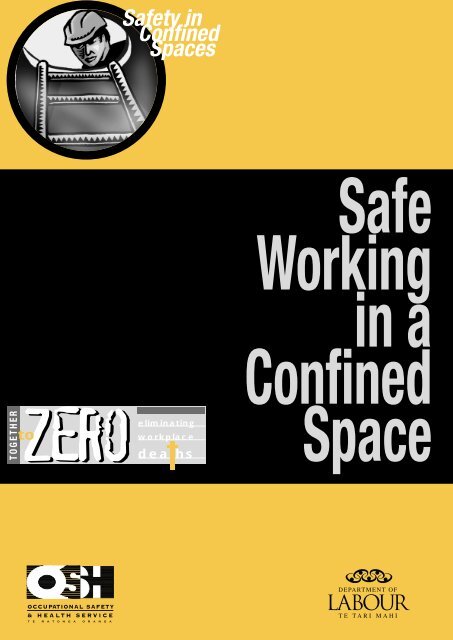

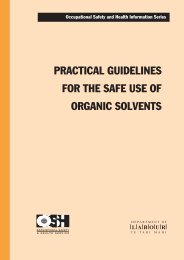
![Task analysis worksheet [161 KB PDF] - Business.govt.nz](https://img.yumpu.com/51400981/1/190x135/task-analysis-worksheet-161-kb-pdf-businessgovtnz.jpg?quality=85)

